The Perfect Pot Ideas: Container Aesthetics that Are Good for Your Plants
Have you ever glanced at your plant containers and thought, “Hmm, these containers just scream…dull!” Yeah, me too. Let’s face it, most store-bought planters can be as about as exciting as watching paint dry. But here’s the secret: your plants feel the same way! They’re yearning for a stylish upgrade, a place that reflects their vibrant personalities and, more importantly, keeps their roots healthy and happy.
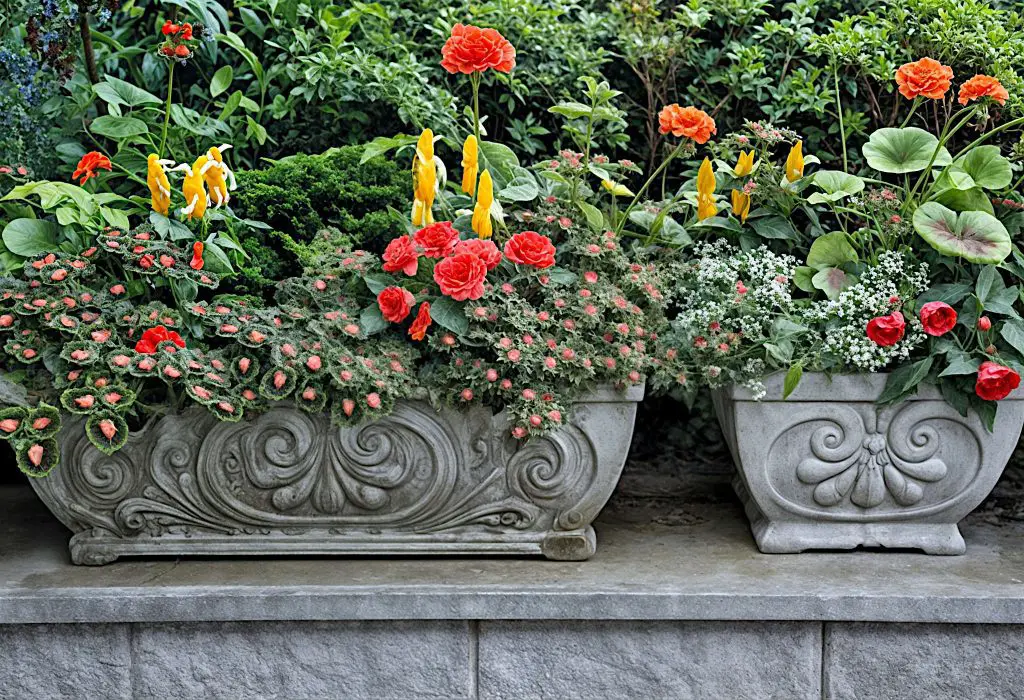
When container gardening, think of it this way: your plant’s pot or container as its entire world. It’s where they sleep, eat, and, well, photosynthesize. Wouldn’t you want to live in a place that’s not only comfortable but also reflects your unique style? If you feel that you could make improvements then it is time to start to transforming those plastic purgatories into luxurious estates for your leafy companions.
Indeed, world of pot materials and function is quite fascinating. From drainage drama (because trust me, it’s a thing!), to finding the perfect fit, and expressing your plant’s inner rockstar through style. So, grab your gardening gloves and let’s get ready to unleash the hidden potential of your plant’s prison…I mean, palace!
The Great Pot Debate: Material Options
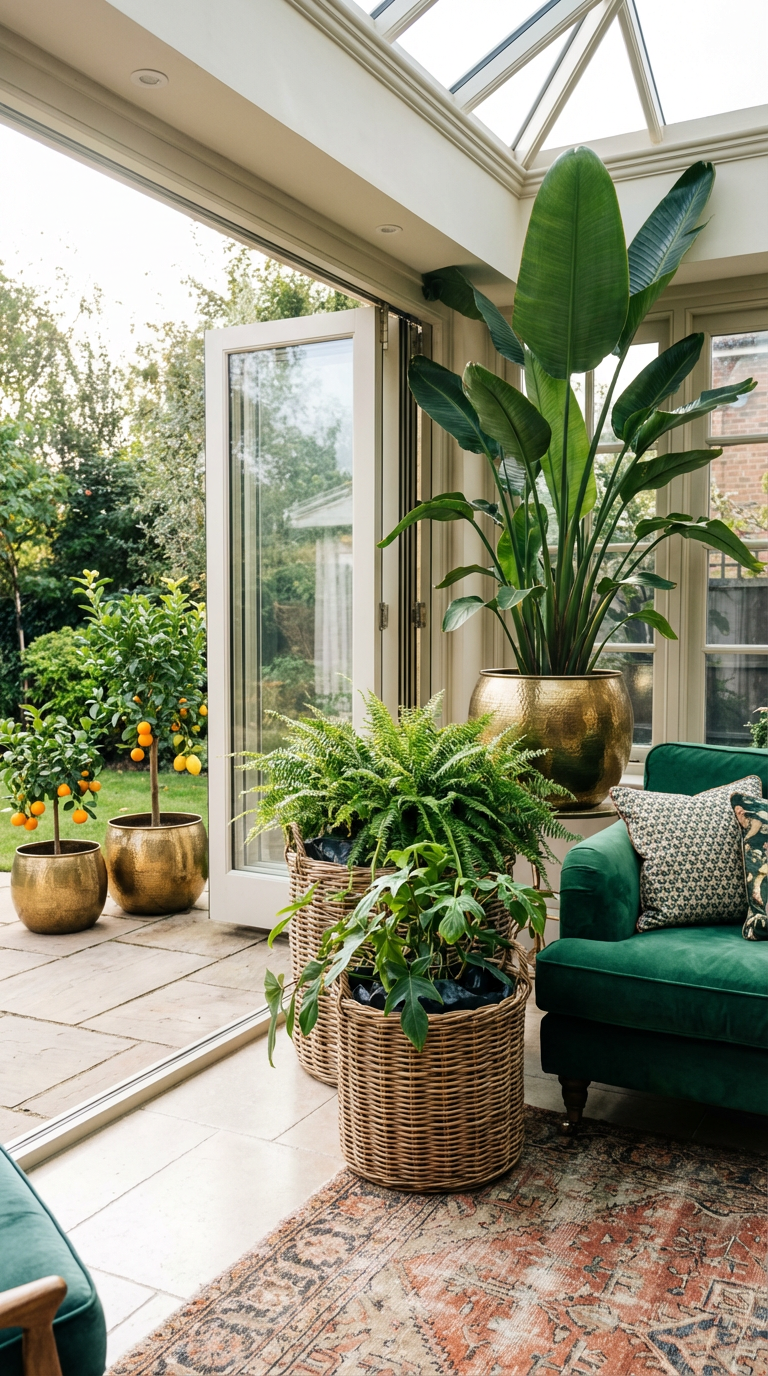
Material and aesthetics often go hand in hand. If you a looking for the perfect look for your container garden the material you pot is made from can play a big role. The five most common materials used are clay/terracotta, plastic, fabric, ceramic and stone. Lets look at each in turn and also consider the material choice has on the plants inside.
Clay Pots
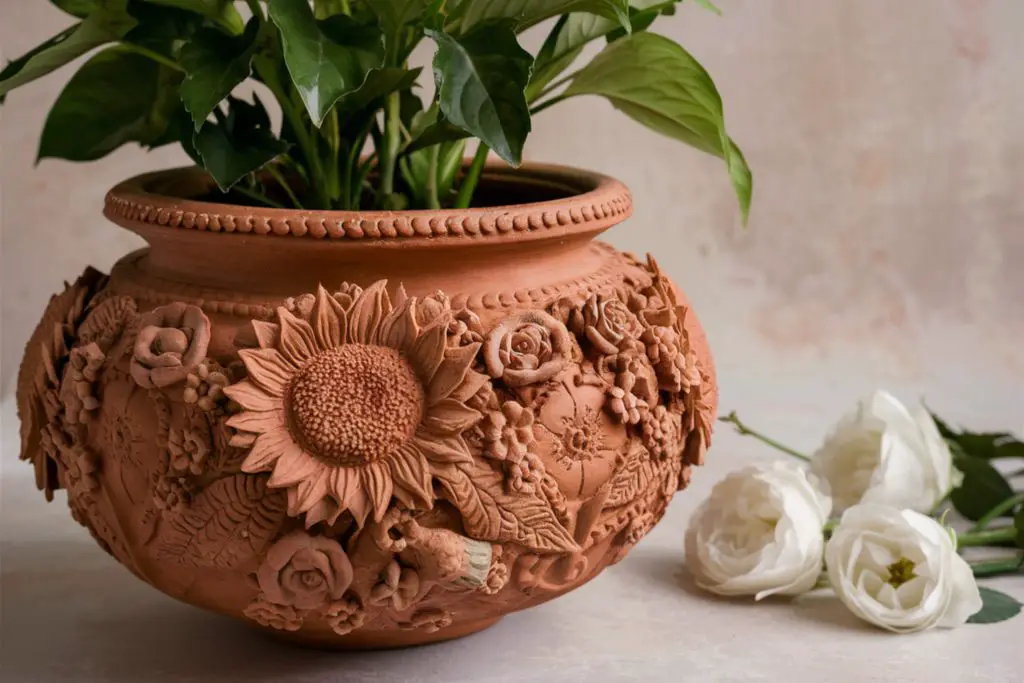
First up in the pot arena, we have the classic clay contender. These terracotta champions are beloved for their breathability, which is essential for preventing root rot. Imagine your plant’s roots doing synchronized swimming – that’s the kind of air circulation clay pots provide. Plus, let’s be honest, they come in some seriously stylish designs, adding a touch of timeless elegance to any room.
But clay companions aren’t all sunshine and roses. They can be real weightlifters, making them a nightmare to move around for those of us who like to rearrange our plant family every other week. And let’s not forget their Achilles’ heel – they’re prone to cracking. I speak from experience here. One particularly enthusiastic watering session (okay, maybe it was two) resulted in a runaway clay pot incident that left me with a startled cat, a damp rug, and a pile of terracotta shards. Let’s just say the dramatic irony of a “plant prison” breaking free wasn’t lost on me.
However, with a little TLC (tender loving care, not that kind of TLC!), clay pots can be fantastic options. Just be prepared to embrace your inner weightlifter and maybe invest in some pot coasters for those overenthusiastic watering moments.
Plastic: Upcycled Chic
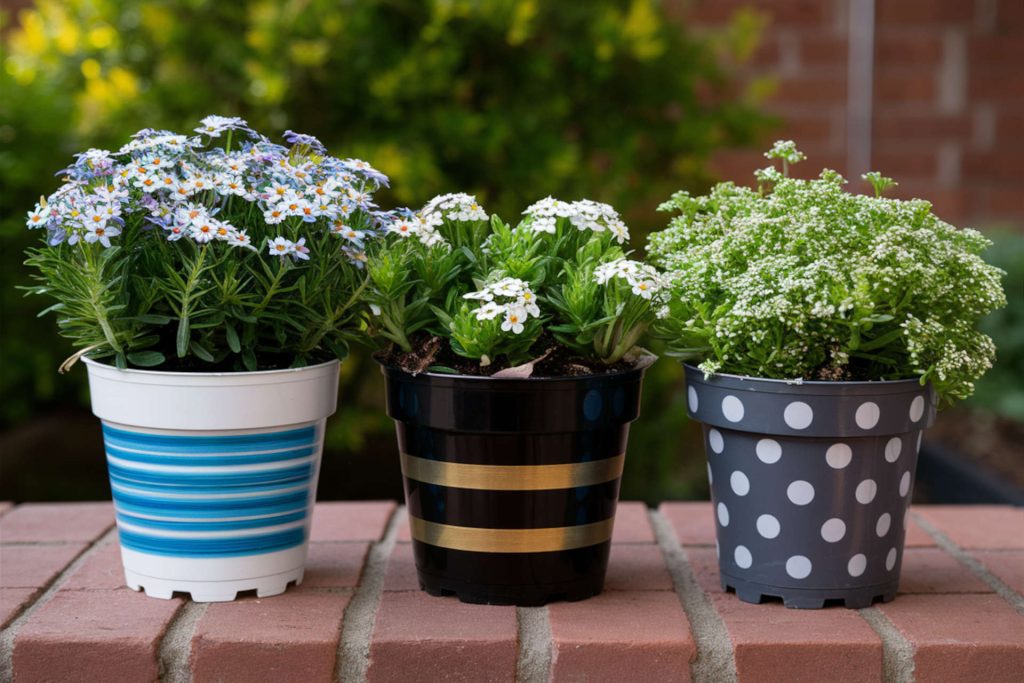
Alternatively, we have the plastic pot: the lightweight and affordable champion. Let’s face it, they’re the college student of the pot world – practical, easy on the wallet, and available in every color imaginable. Plus, for those forgetful waterers amongst us (myself included!), plastic’s ability to retain moisture can be a lifesaver. Imagine your plant snoozing peacefully, knowing its little plastic world won’t dry out into a dusty wasteland overnight.
However, plastic isn’t all sunshine and rainbows. While they breathe about as well as a deep-sea diver, this can lead to root rot for plants that prefer a good airing out of their root zone. There’s also a chance of chemicals leaching from the plastic into the soil, which isn’t exactly a five-star spa treatment for your leafy friends. Style-wise, let’s just say they can be a bit…well, boring.
Customising Plastic Pots
While plastic pots offer affordability and convenience, they sometimes lack the aesthetic appeal of other materials. In truth, plastic pots are, well, just plain ugly! They don’t have to remain that way as you can you your inner creative instincts to turn these unsightly mass produced items into individual works of art. You don’t need to be Picasso either. A roll of colored tape and or a pot of paint and you can completely transform them.
Combining Fabric Flair with Mundane Plastic Pots
If you are looking to be a little more adventurous in your customisation then fabric can come to the rescue with a budget-friendly and customizable way to transform your plastic planters. You can breathe new life into plain plastic pots with a splash of fabric. It’s a cost-effective way to create unique and stylish planters that complement your decor.
Unleash your creativity with endless fabric choices! From bold patterns to calming neutrals, the possibilities are endless. You can even personalize your pots with hand-painted designs or embroidery.
Upcycling Other Plastic Items Into Unique Planters
But wait! If just the general shape of plastic pots puts you off, it doesn’t mean as a material you banish the idea of plastic pots to the recycling bin completely. Here’s a pro tip: unleash your inner artist and upcycle! A brightly colored plastic bucket can be transformed into a quirky planter with a little paint and some creativity.
Just be sure to drill drainage holes if it doesn’t have any – after all, even plastic fantastics need a way to breathe occasionally!
Fabric Pots: Champions of Drainage

Now, entering the ring with a flourish, we have the fabric pots! There is much more that you can do with fabric that just customise or cover an ugly plastic pot. In fact fabric is used to to make stand alone pots for your plants.
Fabric creates innovative planters. These are made from breathable fabric, which is like a breath of fresh air (literally) for your plant’s roots. Imagine them doing jumping jacks for joy – that’s the level of aeration fabric pots provide. This not only prevents root rot but also encourages healthy root growth, leading to happier, more vibrant plants.
However, with great breathability comes great responsibility (or, well, frequent watering responsibility). Fabric pots can wick away excess water, helping to maintain optimal moisture levels for plant roots, however because fabric allows for so much airflow, these pots can dry out quickly, especially in hot weather. Think of them as the sprinters of the pot world – they need constant attention to stay hydrated.
Now, the question you might be asking is: “Do fabric pots really make a difference?” Well, science is here to back it up! In a fun experiment, I planted identical tomato plants in three different pots: clay, plastic, and fabric. The fabric pot came out on top every time, boasting a larger root system and a significantly higher yield of juicy tomatoes. So, while they might not win any beauty contests, fabric pots are true champions when it comes to plant health.
Glazed Ceramic Pots: Striking a Balance Between Style and Function
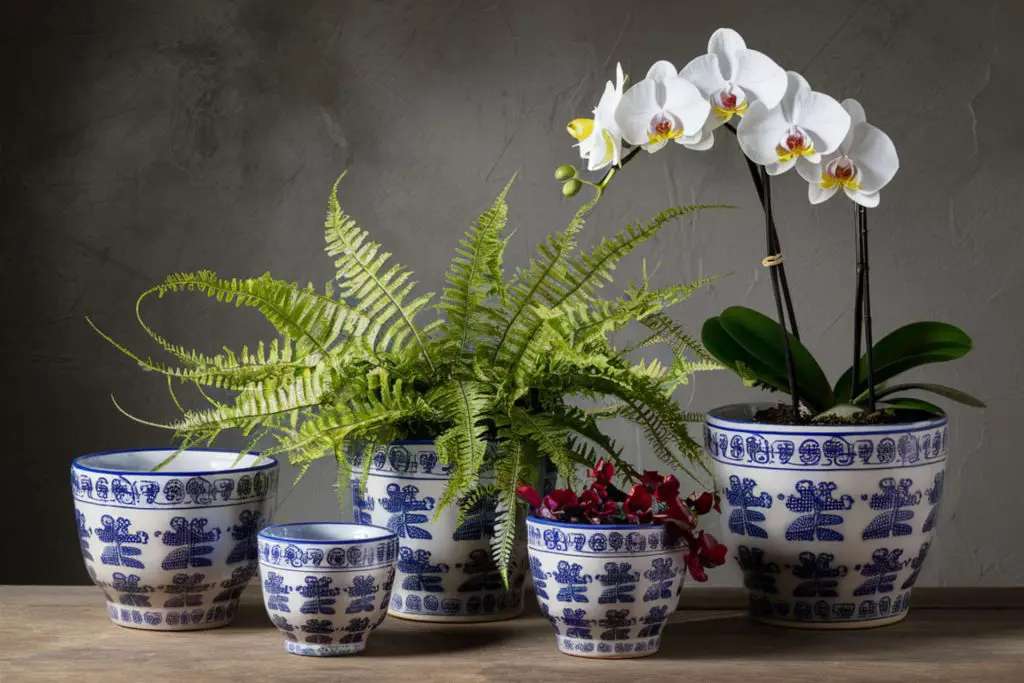
Glazed ceramic pots offer a captivating blend of style and functionality, making them a popular choice for plant parents. While they share some similarities with traditional clay pots, the addition of a glaze creates unique properties to consider.
The Allure of Glazed Ceramics:
- Aesthetic Appeal: Glazed ceramic pots come in a dazzling array of colors, patterns, and finishes. From sleek and modern to vibrantly boho, there’s a glazed pot to complement any decor style.
- Smoother Surface: Unlike terracotta, glazed ceramics boast a smooth, non-porous surface. This makes them easier to clean, prevents dirt build-up, and adds a touch of sophistication.
Balancing Beauty with Practicality:
- Drainage Considerations: Glazed ceramics can be less breathable than terracotta due to the glaze coating. While some glazed pots come with drainage holes, others might not. If opting for a pot without drainage, be extra cautious with watering to avoid overwatering. Consider using a well-draining potting mix or adding a layer of gravel at the bottom of the pot to create a reservoir for excess water.
- Weight Matters: Similar to clay pots, glazed ceramics can be quite heavy, especially in larger sizes. This might be a consideration for those who like to frequently rearrange their plant family.
Stone Planters: Timeless Beauty, Built to Last
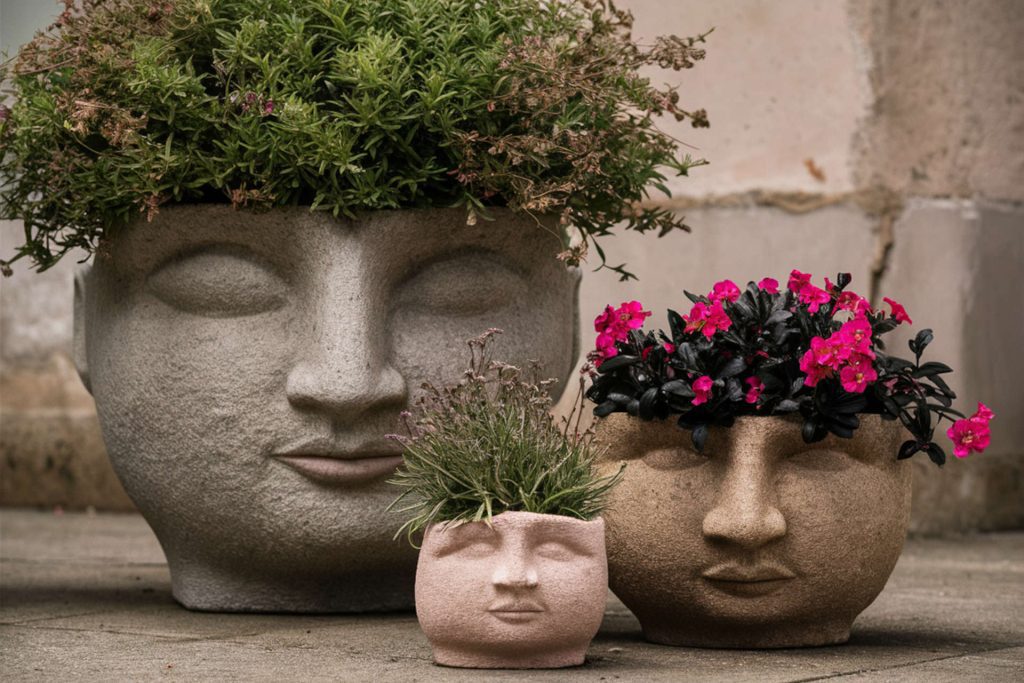
For those seeking an heirloom-quality planter, look no further than the stone titans. Crafted from granite, basalt, or even marble, these heavyweights exude an aura of timeless elegance. Imagine your prized Fiddle Leaf Fig basking in the dappled sunlight, its vibrantly green leaves perfectly complemented by the classic lines of a hand-carved stone pot. It’s a match made in horticultural heaven, guaranteed to turn heads and elevate the aesthetic of any indoor or outdoor space.
But like a prized antique, stone planters come with their own set of quirks. First and foremost, they’re the Arnold Schwarzenegger of the pot world – incredibly strong and durable, but also the heaviest contender. Rearranging your plant family with a stone titan? Let’s just say it’s a workout for the dedicated plant parent. They also tend to be the most expensive option, requiring a serious commitment to your leafy companion.
Drainage can also be a bit of a challenge with stone planters. While some come with built-in drainage holes, others might require a bit of DIY intervention. The key here is to ensure proper drainage to avoid drowning your plant’s roots.
Speaking of DIY, I once spent an entire afternoon scouring antique stores to find the perfect stone pot for my grandfather’s jade plant. It was a heavy beast, but the look on his face when I finally unearthed it (pun intended) was priceless. The combination of the plant’s emerald leaves and the aged stone created a living piece of art, a testament to the enduring beauty of nature and craftsmanship. So, while stone planters might require a little extra muscle and planning, the reward is a planter that will become a cherished part of your home for generations to come.
Material Matchmaker: Finding the Perfect Pot Palace for Your Plant

Choosing the right pot material is all about matching your plant’s needs with the unique properties of each option. Here’s a quick guide to help you find the perfect fit:
| Material | Pros | Cons | Ideal Plant Types |
|---|---|---|---|
| Clay | * Excellent drainage and aeration * Stylish and classic * Breathable, prevents root rot | * Heavy * Prone to cracking * Dries out thirsty plants faster | Cacti, succulents, herbs, flowering plants (with proper watering) |
| Plastic | * Lightweight and affordable * Comes in vibrant colors * Retains moisture | * Not very breathable * Can leach chemicals * Less stylish options | African violets, ferns, peace lilies (plants that prefer consistently moist soil) |
| Fabric | * Excellent drainage and aeration * Promotes healthy root growth | * May dry out quickly * Needs frequent watering * Not the most aesthetically pleasing | Most vegetables, tomatoes, peppers, roses (plants that thrive with good air circulation) |
| Stone | * Durable and weatherproof * Classic and elegant aesthetic * Naturally heavy, prevents tipping | * Heaviest option * Most expensive * Drainage can be inconsistent | Fiddle Leaf Fig, Snake Plant, ZZ Plant (low-maintenance plants that tolerate underwatering) |
| Glazed Ceramic | * Stylish and easy to clean * Wide variety of colors and finishes * Smoother surface | * Less breathable than terracotta * Drainage can be inconsistent (check for holes) * Can be heavypen_spark | Snake Plants, ZZ Plants, Peace Lilies, Philodendrons, Ferns (plants that tolerate slightly moist soil) |
Drainage Drama: Keeping Your Plant’s Feet Happy
Ah, drainage – the unsung hero of the plant world. Think of it as your plant’s way of avoiding a soggy sock situation. Just like we wouldn’t want to walk around in damp shoes all day, plant roots need good drainage to breathe and prevent rot. Imagine them wiggling their little root ends in frustration – that’s what happens when waterlogged soil suffocates them.
So, how does drainage drama play out? Well, the culprit is often overwatering. We all want to shower our leafy friends with love, but too much of a good thing can be disastrous. Excess water sits around the roots, blocking oxygen flow and creating the perfect breeding ground for fungus. The next thing you know, your once vibrant plant starts looking wilted and sad.
But fear not, plant parents! There are ways to keep your plant’s roots happy:
- Drainage Holes are Your BFFs: Most pots come with drainage holes at the bottom, and for good reason! These little perforations are your plant’s lifeline, allowing excess water to escape. When repotting, choose a pot with drainage holes or consider adding them yourself (drill bits are your friend!).
- Drainage Deficiencies? No Problem: Don’t have a pot with drainage holes? Don’t fret! Here are some creative solutions:
- Elevated Saucer: Place your pot on top of a saucer filled with pebbles. This elevates the pot and allows excess water to collect in the saucer, preventing it from sitting around the roots.
- Gravel Savior: Add a layer of gravel to the bottom of your pot before adding soil. This creates a reservoir for excess water while keeping it away from the roots.
- The No-Drainage Dance: There are a few plant exceptions who actually prefer constantly moist feet, like African Violets. For these guys, skip the drainage holes and water them from the bottom to keep the soil consistently damp.
Drainage is all about achieving the perfect balance – not too wet, not too dry. If you have an understanding of each of your plant’s needs you can ensure your leafy companions have happy, healthy roots for years to come!
Sizing Up the Situation: Finding the Perfect Fit
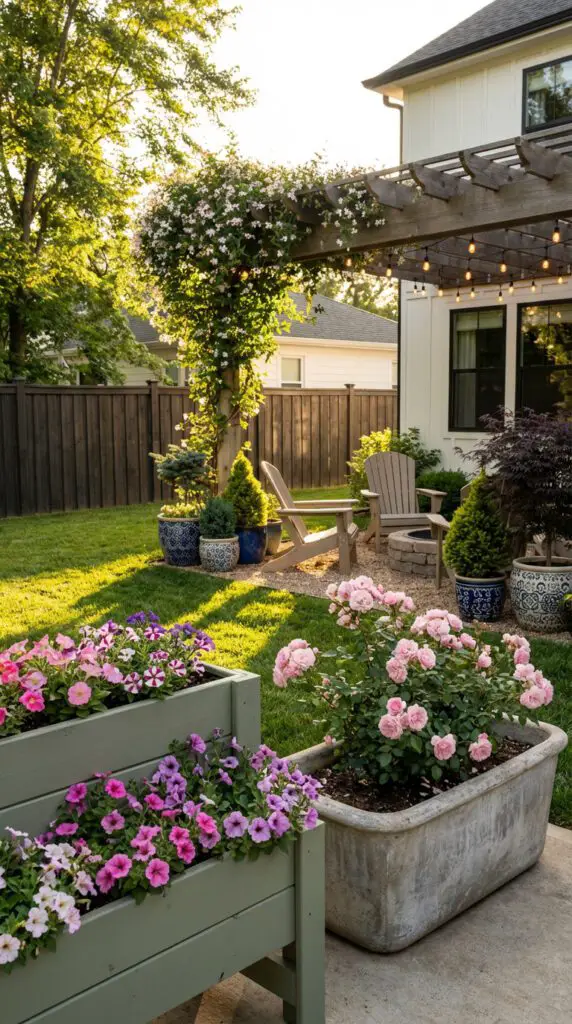
Ever tried shoving your foot into a shoe two sizes too small? Not comfy, right? Plants feel the same way about cramped pots. Choosing the right size pot is crucial for healthy root growth and overall plant happiness. Think of it as giving your plant room to breathe and stretch its roots – literally!
Here’s why pot size matters:
- Big House, Big Dreams: Imagine your plant’s roots as tiny explorers, constantly searching for new territory. A pot that’s too small restricts this exploration, hindering root growth and ultimately stunting the plant’s overall development.
- The “Just Right” Formula: So, how big should your pot be? As a general rule of thumb, aim for a pot that’s 1-2 inches larger in diameter than the root ball of your plant. This provides enough space for healthy root growth without creating an overly large soil reservoir that could lead to overwatering.
- Growth Spurts: Just like us, plants go through growth spurts. A pot that seems perfectly sized today might become a cramped prison a year down the line. Keep an eye on your plant’s growth and be prepared to repot when the roots start circling the bottom of the pot or become visible above the soil line.
Here’s a handy trick to identify a root-bound plant:
- The Gentle Squeeze Test: Gently squeeze the sides of the plastic pot. If the root ball feels firm and the entire pot moves with it, it’s probably time for a bigger home!
Case Study: Witness the Power of Proper Sizing!
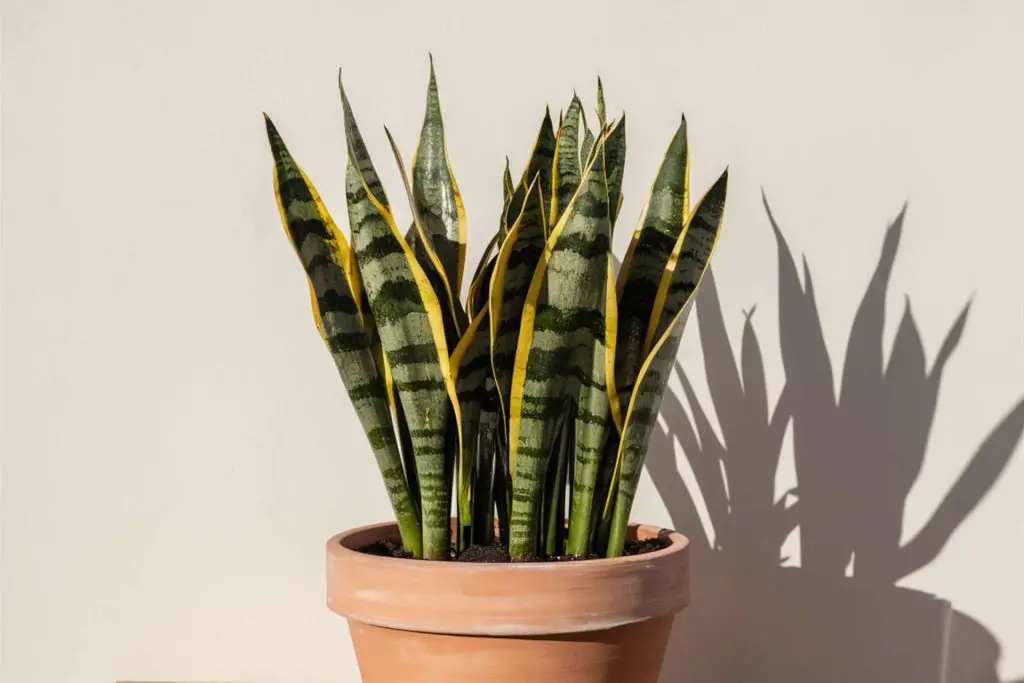
Imagine a sad-looking Snake Plant, its once vibrant leaves drooping listlessly. Upon closer inspection, we discover it’s crammed into a tiny pot, its roots bursting out of the drainage holes in a desperate search for space. Fast forward a few weeks after a repotting into a properly sized container. Our Snake Plant is thriving! Its leaves stand tall and proud, new growth emerges, and it radiates newfound health and vitality. This, my friends, is the magic of proper pot sizing!
Get to know your plant’s growth patterns and following these simple guidelines, you can ensure your favourite plants and flowers have the right amount of space to thrive and reach their full potential. Remember, happy roots equal happy shoots!
Let’s face it, plants aren’t just living organisms – they’re living works of art! And just like any beautiful picture deserves the perfect frame, your plant deserves a pot or container that reflects its unique personality and complements your garden setting, or if your container garden is inside, your home decor. Think of it as dressing your plant for success – a stylish pot can elevate the entire space and showcase your inner plant stylist.
From Minimalist Chic to Bohemian Paradise:
The world of pot styles is as vast and varied as the plant kingdom itself. Minimalist planters in sleek ceramic or cool concrete can add a touch of modern sophistication to your living room. For a bohemian vibe, consider woven baskets or macrame plant hangers that bring a natural texture and a touch of the unexpected. The possibilities are endless!
Let’s Get Crafty: Unleash Your Inner DIY Diva
Don’t feel limited to store-bought options! Embrace your inner DIY guru and unleash your creativity on a plain terracotta pot. A splash of paint, a mosaic design using broken tiles, or even a layer of washi tape can transform a basic pot into a work of art. Upcycled vintage tins or painted buckets can add a quirky touch to your plant family, while repurposed teacups or teapots create a charming miniature garden scene.
Plant Personalities: Matching Style to Substance
Just like people, plants have their own unique personalities. Here are some ideas for matching pot style to plant type:
- Spiky Succulents: Pair these low-maintenance beauties with geometric planters or rustic clay pots that complement their desert vibes.
- Elegant Orchids: Showcase their delicate beauty in sleek glass terrariums or ceramic hanging planters that provide ample air circulation.
- Trailing Vines: Let their cascading foliage take center stage with a macrame plant hanger or a hanging basket in natural fibers.
It is goods to sometimes remind ourselves that there are no hard and fast rules! The most important thing is to choose a pot that you love and that complements your plant and your home decor style. So, have fun, experiment, and let your creativity bloom! After all, a happy plant parent with a keen eye for style is the secret ingredient for a thriving indoor jungle.
Final Thoughts
Choosing the perfect pot or container might seem like a simple task, but as we’ve explored, it has a significant impact on the well-being of your plant. From ensuring proper drainage and aeration to providing adequate space for root growth, selecting the right pot is an investment in the long-term health and happiness of your leafy companion.
A well-chosen pot goes beyond functionality. It can elevate your plant’s presence, transforming it from a simple houseplant into a vibrant focal point in your home. Always consider the material, size, and style of the pot, so you can create a harmonious environment that reflects both your plant’s needs and your own personal aesthetic.
